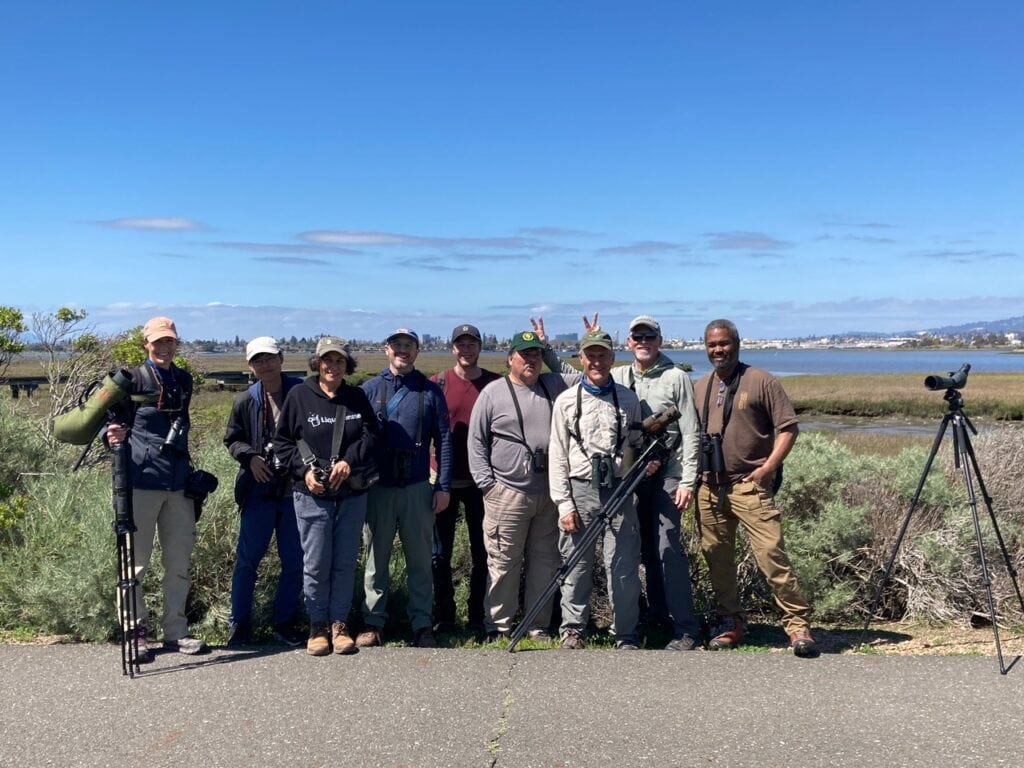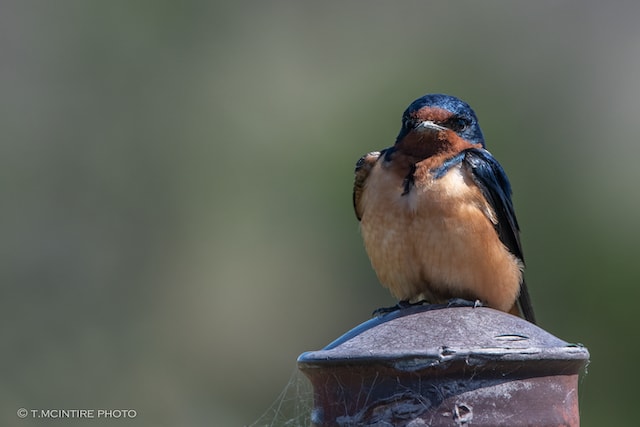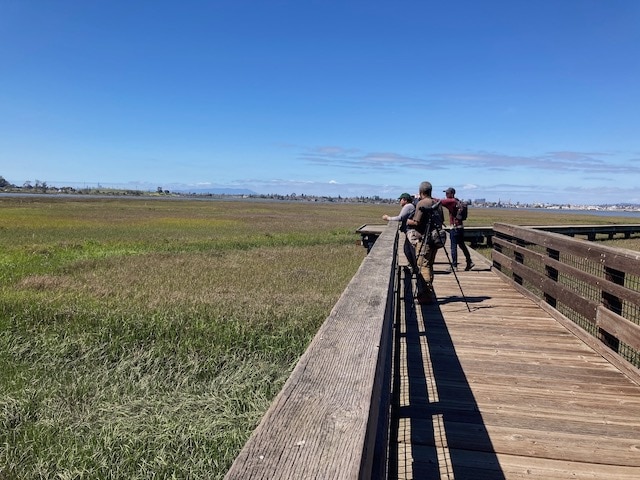Bay Birding Challenge: East Bay Scrub Jays
By Derek Heins (East Bay Scrub Jays Team Captain)

On Saturday, April 1, Anne Ardillo, Dan Roth, Clay Anderson, Alex Henry, Tara McIntire, Jeff Manker, Eric Schroeder and I comprised the East Bay Scrub Jays, competing against the Stork Raven Mad team from San Francisco as part of Golden Gate Bird Alliance’s “Bay Birding Challenge”. We also had Jaewon Lee, a member of the UC Berkeley Bears for Birds Audubon club, with us to help document and capture our “Big Day”.
We executed an extensive plan that took into consideration the unique physical layout of our side of the Bay, timing of tides, and the interesting time of year regarding spring migration.
When planning a one-day effort, it is fascinating to learn when each non-resident species begins its migration movements. In our case, we have a lot of waterfowl and passerines starting their migrations north in March. This often made what a couple weeks earlier was an easy species to find, very difficult. On the other hand, in the week or two leading up to April 1, we started to see reports of spring arrivals such as Wilson’s Warblers and Pacific-slope Flycatchers.
So, with that in mind, we met a few minutes before daylight (the agreed upon start and end times being dawn and dusk) at the Skyline Gate Staging area of Redwood Park, our only scheduled stop high in the Oakland Hills. As expected, our first species recorded was a Great Horned Owl hooting. Fortunately, it was not foggy and as it got lighter, activity picked up nicely as we started finding our key targets including a Varied Thrush singing, both Red-breasted and Pygmy Nuthatch, Brown Creeper, Purple Finch, Hairy Woodpecker and Townsend’s Warbler. The best bird in that location was an overwintering Townsend’s Solitaire, first heard calling but later seen with great views. We also picked up Cooper’s, Sharp-shinned Hawks and Western Bluebird. Our pipe dream of getting a Pileated Woodpecker didn’t pan out.

Energized by 36 quality species at our first stop, we drove to Lake Temescal where 20 American White Pelicans were lit up by the morning light. We picked up all five expected swallow species, a Green Heron flew across the lake and two recently arrived Wilson’s Warblers were feeding in the willows.
We then headed down to the Bay at Miller Knox Park where we immediately found a Eurasian Wigeon amongst American Wigeon in the main pond, along with a Gadwall pair. Our target here was primarily seabirds, so we quickly set up to scope the bay and picked up some grebe and duck species. Loons have almost all left the Bay to migrate north, but we did spot one Common Loon. Other species included American Pipit, Spotted Sandpiper, Sanderling, Fox Sparrow, Black-crowned Night-Heron, Allen’s Hummingbird, Cedar Waxwing, Brown-headed Cowbird and a Downy Woodpecker at the parking lot just before departing. A Western Tanager seen the day before was not found.
A short hop took us to the Canal Boulevard viewing platform where we scanned the bay and Brooke’s Island quickly. A scream announced a great find, a single Snowy Plover on the Brooke’s Island shoreline, which we were able to ID from the commonly seen and similar looking Sanderlings. We also added Brant which winter there, Surf Scoter, Common Goldeneye, Black Oystercatcher, flyover Whimbrels, Caspian Tern, and an Osprey seemed to be contemplating landing on one of our heads. The pair of overwintering Black Scoters might have still been around but were not spotted and it was too late for a decent shot at finding a Brandt’s Cormorant.

In route to Albany Bulb, a White-throated Swift was seen flying near one of the I-580 overpasses. At the Bulb we picked up Lincoln’s Sparrow, Western Meadowlark, Forster’s Tern, American Avocet (our 100th species of the day), Green-winged Teal, Marbled Godwit, Black Turnstone, Semipalmated Plover and House Sparrow (don’t laugh, we missed it last year, both list-wise and emotionally).
A couple minutes away we began our search for the Northern Parula that was discovered by Alex on March 19 in the now celebrated birder’s paradise known as the Albany Target parking lot. Sure enough Alex was the first to spot it briefly after a frantic search, but it took another five to ten minutes for him to re-find the rare bird and help the rest of us see it. The 25 minutes spent there paid off as we also saw our only American Goldfinch and Hutton’s Vireo and our first Orange-crowned Warbler. On the way to the Emeryville seawall we spotted the expected Snow Geese along the frontage road, our only White-tailed Kite and a Greater Yellowlegs. The Emeryville seawall was immediately productive as we heard Elegant Terns, saw Northern Shoveler, scoped over toward the Bay Bridge and saw ten Black Skimmers and also picked up the expected Surfbirds that love to roost along the seawall itself. Realizing that we hadn’t seen a Pelagic Cormorant yet, we ran across the street and quickly found a Pelagic Cormorant in the marina.
The clock struck noon as we drove under the bay through the Webster Tunnel to make another quick stop at a great spot Jeff discovered a few weeks ago in a housing development called Mosley Marsh. It’s fenced in but viewable because the vegetation inside the fence was cleared out recently. We searched intently but couldn’t find the “regular” Wilson’s Snipe although we did see a Sora swimming along the reeds and a few Ring-necked Ducks. As we congregated back at the cars, Tara spotted a kingbird far off in the field across the street that we initially entered as a Western Kingbird. Come to find out post-trip, the bird she saw was actually a Tropical Kingbird after reviewing a clearer photo Alex took during the day. We were in such good shape timewise that we diverted to Ballena Bay to see if we could pick up some yet-to-be-seen waterfowl and shorebirds. We dipped on the specific targets, but did see our only Belted Kingfisher of the day. We made one more stop on Alameda Island at a known Barn Owl roost but dipped again.

Because of our success finding Snowy Plover and all the expected tern species, we skipped Elsie Roemer (saving a budgeted half hour) and left Alameda Island toward MLK Shoreline. By Doolittle Pond we got our only Savannah Sparrow, Short-billed Dowitcher and Cinnamon Teal while scanning for the Bald Eagles that were still around despite the severe wind damage to their nest at Corica Golf Course. Jeff knows the eagle pair’s regular roosting spots, but we came up empty-handed. Slightly deflated but determined as ever, we drove to the main parking lot by Arrowhead Marsh. We picked up overwintering Blue-winged Teal, saw and heard Ridgeway’s Rail, and also got Marsh Wren and a Long-billed Dowitcher. Surprised that we didn’t have a Common Yellowthroat, we headed around the paved path to seek one out. Dan and Alex excitedly thought they had a female but unfortunately upon better views,realized it was an Orange-crowned Warbler. That was probably our biggest miss of the day. Because of the time saved earlier, we diverted to Garretson Point to try for a couple missed waterfowl species and did get a male Northern Pintail. While we were scanning the mudflats at low tide, Tara and Anne saw a Merlin streak by on its way to buzz the shorebirds. That was a great sighting that gave us 142 species for the day with a huge territory yet to cover by sundown.
That was it for the shoreline as we took our longest break to head over to Shadow Cliffs in Pleasanton, hoping some target species hadn’t migrated north. The easiest and most critical target there was Great-tailed Grackle which we got. We walked along the levee looking down into the back channel and from the concrete bridge got a pair of beautiful Wood Ducks. Unfortunately, we couldn’t find any Hooded Mergansers and our hopes for finding any that hadn’t migrated yet were dashed. The only other pickup at Shadow Cliffs was White-breasted Nuthatch.
It was time for another diversion, this time to Brushy Peak near Livermore where we got a Barn Owl in a nest box. There were a few American Kestrels, but a great pickup occured when Derek spotted something barely viewable in a tiny seasonal wetland that finally shifted and became a Wilson’s Snipe!
At that point it was 5pm with our remaining time allotted for driving from Patterson Pass to Cross Road and then over to Mines Road to catch the sunset. Alex quickly picked up a far-off Golden Eagle (species #150 which was our original goal) and Say’s Phoebe on Greenville Road and California Quail on Cross Road (yes, sadly our first). In scouting the area a week earlier we saw three Cassin’s Kingbirds, but they did not show for us. And it appears the Tricolored Blackbirds here and there that mix in with blackbird/starling flocks during the winter have formed Tri-flocks and are further east seeking nesting locations so we dipped on them too.
On Mines Road, we quickly picked up a Yellow-billed Magpie on a telephone wire while driving and then stopped shortly after to pick up a Lewis’ Woodpecker low on a snag and a Phainopepla at the top of an oak tree. About a mile down the road, we stopped by the concrete bridge and in great late daylight, saw another Phainopepla on a far-off oak tree. A couple little white dots a few feet away in the same tree quickly became another key target, Lark Sparrows! We then drove uphill, our hopes high for a few last species known in the rocky, chaparral habitat. It was not easy that late in the evening but fortunately I was in the company of people with great aural birding skills, and in this case it resulted in Alex yelling “come over here” where he, Jeff and Clay, heard and saw a Blue-gray Gnatcatcher which was a top five bird of the day.
Slightly uphill from there, near “the Roadrunner House”, Tara saw a thrasher that quickly snuck away and no one else could see (per the Challenge rules at least two members of the party have to ID the bird). We then drove further uphill, frantically looking for good Rufous-crowned Sparrow habitat but not having any luck. So we turned around and came back down to the Roadrunner house and finally we heard Wrentit singing far away. As time was running out, someone shouted “California Thrasher!!!” and one was heard calling far away for species #159. We thought our day was over, and had already poured the champagne and toasted to the birds and Team Scrub Jays, when someone heard a Rufous-crowned Sparrow. That’s when we realized we had hit the magical 160 mark!
In addition to the biggest misses already noted, you can add Canvasback (either for Albany Mudflats or Doolittle Pond), Rufous Hummingbird (so close a couple times but couldn’t confirm), Short-billed Gull, Red-throated Loon, Northern Harrier, Red-breasted Sapsucker (one seen March 31 at the Skyline Staging parking lot), Pacific-slope Flycatcher and White-throated Sparrow. What do all of these have in common? They either departed before April 1st or haven’t arrived yet in numbers. Selecting a date for a big year has a huge impact on what species you can find in a one-day period.
A full trip report can be found here: https://ebird.org/tripreport/111845
Keep in mind that most of the 27 eBird checklists are marked “incomplete” because Eric the recorder couldn’t possibly get every species at every spot, nor an accurate count for each species. So, it might look like we only saw a species once (Surf Scoter for example) when in actuality we saw it multiple times. As team members each review the checklists they might make changes, but the 160 species count is locked into the East Bay birding halls of glory!
While long-winded, this report reflects a very long, action packed day. We had a group who were meeting for the first time, but the experience left us in awe of what a team composed of individuals with a blend of skills can accomplish. Yes, it was birding, but it truly was much more.
P.S. Even though the competition for species count is over, the race to see which team can raise the most money for Golden Gate Bird Alliance is still on! Help us ensure a win for the East Bay and our Bay Area birds, wildlife and habitat by giving a one-time donation to our campaign page here.
Derek Heins is the Golden Gate Bird Alliance Treasurer. For those who know Derek Heins, his “Hummingbird Heins” nickname came not only from his love of everything bird related but also his energy in finding them biking and hiking all over the East Bay and beyond. Derek’s local birding began when he and his wife Cristina joined a GGBA field trip to Grizzly Island in 1989, translating an interest he had as a youngster into an all-consuming passion.
